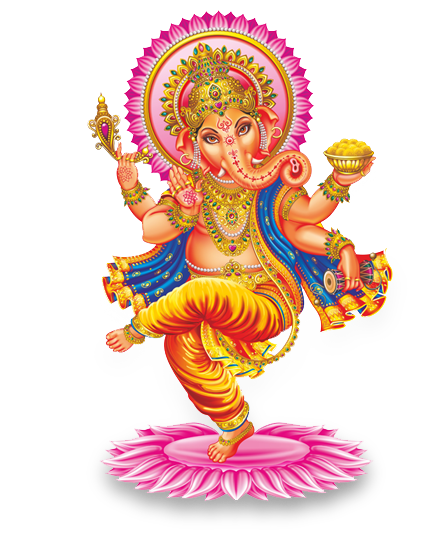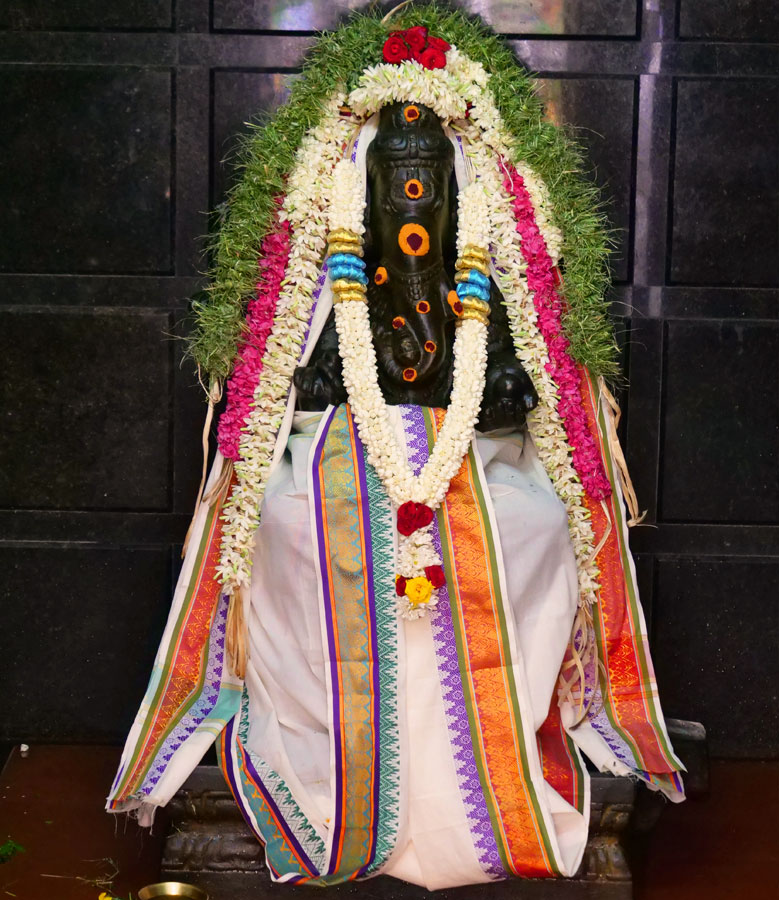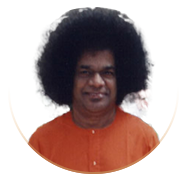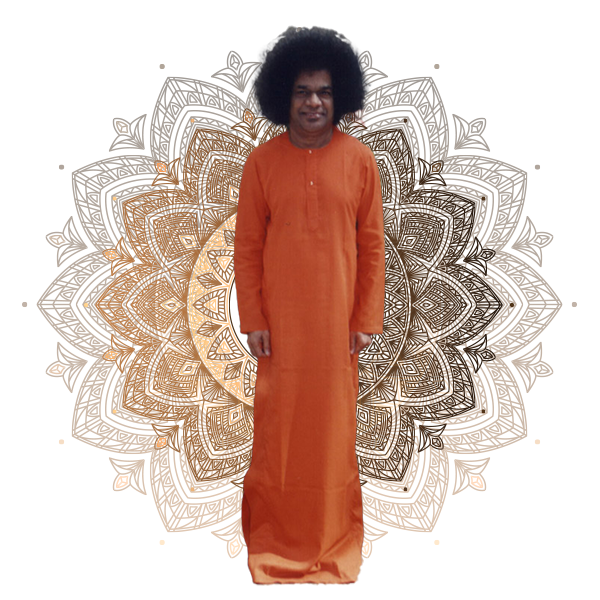DESCRIPTION
Sri Gnana Mukthi Vinayaka/Ganesha
Lord Vinayaka is also known as Ganapati and Ganesha. He is one of the best known and most worshipped deities in India and in Nepal, Sri Lanka, Thailand, Indonesia etc. He is known as the One who removes obstacles, that is why many worshippers pray to Him first. He is the Son of Lord Shiva and Mother Parvathi. No wonder His temple is situated close to the gates of the Mukthi Nilayam Ashram, the abode of Shri Sathya Sai Baba and His Mula Shakthi, Sri Vasantha Sai. ‘Gana’ – ‘Ga’ stands for Buddhi (intellect). ‘Na’ means ‘Vaijnaana’ – the highest knowledge or wisdom. Ganapathi is the Lord of the intellect and the higher knowledge. Parvathi signifies ‘Prithvi’, Mother Earth. All are children of the Earth. His vehicle is the mouse (Mooshika) which is the symbol of darkness (ignorance). Ganapathi controls the darkness of ignorance. He has a form of the elephant – the symbol of might and magnitude, removing obstacles very easily.
Source: Halinka Bykowska
Ganesha is also known as Ekdanta, or the one with one tooth, because one of his tusks is broken. The reason for this, according to Padma Purana, is that one day when Lord Shiva was sleeping, sage Parashurama came to visit him. However, Ganesha would not allow Parashurama in, for his father’s sleep would be disturbed. When Parashurama insisted he be permitted entry, a fight broke out. In the course of their struggle, Parashurama threw his axe at Ganesha. This axe had been given to Parashurama by Lord Shiva. Recognizing the axe and out of reverence for his father, Ganesha refused to intercept the weapon. He bowed and took its impact on one of his tusks, which broke. This broken tusk was used by him to write the epic, Mahabharata. Ganesha, the embodiment of wisdom, is also depicted as a scribe to whom sage Vyasa dictated the Mahabharata. He is accepted as the god of learning and the patron of letters.
Lord Ganesha is the presiding deity of the Mooladhara Chakra, which is the foundation of the evolutionary, creative or primeval energy called the Kundalini Shakthi. It is coiled up like a snake when dormant and is depicted by the snake around Lord Ganesha’s belly. When activated, this energy is said to result in an expansion of consciousness and the enlightenment of man. The snake around Lord Ganesha’s belly reminds us that we have to awaken this energy to reach the state of expanded consciousness. The snake around the belly also shows that everything in nature (the pot-belly) is supported by energy.
Lord Ganesha has four arms. The four arms represent the four inner equipment of the subtle body, namely mind (manas), intellect (buddhi), ego (ahankar) and conditioned consciousness (chitta). Lord Ganesha represents the pure consciousness – the Atman – which enables these four equipment to function in us. In one hand he holds an axe. The axe symbolizes the destruction of all desires and attachments and their consequent agitations and sorrows. The other hand is shown in a blessing pose, which signifies that Ganesha always blesses his devotees. In the third hand he holds a rice ball (modaka). Modaka represents the joyous rewards of spiritual seeking. A seeker gains joy of satisfaction and contentment as he progresses on the path of spiritual evolution. Modakam is a sweet cake. The modakam consists of an outer flour portion and an inner sweet portion. The inner sweet portion represents the supreme. The message is that man must dive within himself and transcend the outer, in order to find the inner treasure. In the fourth hand he holds a lotus. The lotus represents the supreme goal of human evolution. By holding the lotus in his hand, he draws the attention of all seekers to that supreme state that each one of them can aspire for and reach through proper spiritual practices.
IMPORTANT NOTICE
In Mukthi Nilayam, in addition to the Sri Gnana Mukthi Vinayaka temple, there are also statues of Shodasha Ganapathi, the 16 forms of Lord Vinayaka on the first prakaram of the Stupi. Shodasha Ganapathi means sixteen Ganapathi forms corresponding to 16 tithis of a lunar calendar

RITUAL WORSHIP
Offerings, Rituals and Pooja
Lord Ganesha is known for his intellect and wisdom. A legend explains why Ganesha is worshipped before any other deity or prior to any important event. It happened that Lord Shiva asked Kartikeya and Ganesha – his two sons – to circle the world and return. Kartikeya hurried off on his peacock, but Ganesha walked around Shiva and Parvati. He explained that for him, his parents constituted the world. Pleased, Shiva granted him a boon, saying that before undertaking any important task, people would pray to Ganesha. According to the Narasimha Purana, if he is not worshipped at the beginning of a ceremony, he creates obstacles for the performers. Therefore, no matter what the occasion or ceremony be, Ganesha is worshipped before all other deities.
Ganesha, who is largely a universally loved God, is generally worshipped before the start of any occasion, function or even business venture. Devotees also offer Ganesha sweets like modaks and laddus. He is often shown carrying a bowl of sweets, called a modakapātra. He is also sometimes worshipped with red sandalwood paste (raktacandana) or red hibiscus flowers. Durva grass or Cynodon dactylon and other materials are also used in his worship.
Being the God of Transitions, Ganesha is placed at the doorway of most Hindu temples. In fact, all Hindu temples; irrespective of who the main deity is; necessarily have at least one shrine dedicated to Vighnavinayaka. Devotees first visit this shrine, pray to Ganesha to absolve them of their sins and only then proceed to the main sanctum.
Ashtavinayaka Yatra
There are eight forms of Vinayaka, collectively referred to as Ashtavinayaka (‘Ashta’ in Sanskrit means ‘eight’). The Ashtavinayaka Yatra implies a pilgrimage to the eight Vinayaka temples, which can be found in the Indian State of Maharashtra, situated in and around the city of Pune. The Yatra follows a particular route, in a pre-ascertained sequence. Each of these ancient Ashtavinayaka temples features a distinct murti (idol) of Ganesha and has a different legend behind its existence. Undertaking an Ashtavinayaka yatra is considered to be holy and bestow a great deal of good on the devotee.
BENEFITS OF WORSHIP
Ganesha, the Hindu deity in a human form but with the head of an elephant – represents the power of the Supreme Being that removes obstacles and ensures success in human endeavours. Lord Ganesha is respected with the first honour of worship, before undertaking any auspicious occasion, or celebration. For the successful completion of any auspicious undertaking, the twelve names of Lord Ganesha are pronounced and praised. One who utters these twelve names of Ganesha while beginning one’s studies, at the time of marriage, while entering a newly constructed house, before setting off for a journey, before setting off for war, or in times of crises, does not come across any obstacles.
The twelve names of Ganesha are as follows : (1) Sumukh (One who has a beautiful face), (2) Ekdanta (Having one tooth, or tusk) (3) Kapil (Kapila – Celestial cow), (4) Gajakarna (One with ears of an elephant), (5) Lambodar (One with a large belly), (6) Vikat (One who is ferocious), (7) Vighna-Nashan (Destroyer of obstacles), (8) Vinayak (Leader), (9) Dhumraketu (the shaping of smoke into a specific form- helping Man in the formation of specific ideas from foggy thoughts), (10) Ganadhyaksha (Leader of the masses), (11) Bhalchandra (One who wears the moon on his head), (12) Gajanan (One who has the face of an elephant).
The symbol of Lord Ganesha is the Swastika. The Swastika is a basic Hindu symbol, reflecting the primary principle of Creation, personalized by Lord Ganesha. The in-depth interpretation of the direction of the swastika proves, that the ancient Oriental mind gives positive answers to the existential problem of the unity of the profane and sacred in human life.
Another symbol associated with Lord Ganesha is the OM. The sign Om is the primary sound of the creation, the holy breath of God, the primary word or the primary verb. Lord Ganesha’s form is shaped like and represents Om, which is the primeval, creative energy. When the elephant cries it produces a sound akin to the Om. The Om is the sound symbol of Brahmam, Sivam, the Eternal, the Unchanging, the substratum of all existence.

MANTRA OR SLOKA FOR INVOCATION
Hindu religious texts recommend the worshipping of Ganesha before the beginning of any religious, spiritual or worldly activity. His most popular mantras are:
“Om Shri Ganeshaya Namah”
“Om Gam Ganapataye Namah”
Mantra Benefit
Chanting this mantra with faith can get for the devotees the immense blessings of the benevolent Lord. This can result in benefits that are manifold. It can remove impediments and delays, make actions fruitful, take all beginnings to their logical end and provide success in all endeavors. Its regular chanting can also discipline the mind, improve its concentration and ability, provide good clarity of thought and bestow the capacity to convert focused thinking into fruitful action.
Vinayaka Stotra
Pranamya shirasaa devam gaurii putram vinaayakam
Bhaktaa vaasam smarenha nityam aayuh kaama artha siddhaye
The meaning of this stotra (religious hymn) is that one should bow one's head and offer obeisance before the son of Gauri, Vinayaka (or Lord Ganesha), whose abode is the devotees, and remember Him always for the purpose of obtaining longevity, desired powers and prosperity.
Stotra Benefit
This stotra is from Narada Purana, and is recited to remove all troubles and get liberation.
Ganesh Gayatri
Om Eka Dantaya Vidmahe
Vakra Thundaya Dhemahi
Thannoh Dhantih Prachodhayath
Om Shanti ... Shanti ... Shanti
Realizing that Elephant-faced One, with one tusk is God; Meditate on the One Who has a curved trunk; May He enlighten our intellect.
SPECIAL DAY OR FESTIVAL
Auspicious Day
Tuesday is considered to be the best day to worship Lord Ganesha. However, if you have full trust in the almighty, if you had faith in him then the day is just an excuse. We can worship him anytime, any day. Tuesday is dedicated to the planet Mercury. Mercury is considered to be the causative planet of intelligence.
Important Festivals
Ganesh Chaturthi
Ganesh Chaturthi, which falls in the shuklapaksha (the fourth day of the waxing moon) in the month of Bhaadrapada (August/September) is the major festival associated with the Elephant-headed Lord. This festival ends on Ananta Chaturdashi day, when Ganesh murtis or idols are immersed in a body of water. Lokmanya Tilak transformed this annual Ganesha festival from private family celebrations into a grand public event in the year 1893. This was done mainly to bridge the gap between the various Hindu sects in existence at the time. Today, this has become a global event, with people from all religions and communities coming together to pray to their favourite God. At home, an appropriately-sized clay image is installed and worshipped by offering puja and prasad (typically Modaks and laddus) with family and friends.
Ganesh Jayanti
Ganesh Jayanti, also known as Magha shukla chaturthi, is the occasion which celebrates the birth day of Ganesha, the lord of wisdom. It is a popular festival particularly in the Indian state of Maharashtra and is also celebrated in Goa held during the Shukla Paksha chaturthi day (fourth day of the bright fortnight or the waxing moon) in the month of Maagha (January/February) of every year. On the festival day, an image of Ganesha, in symbolic conical form is made out of turmeric or sindhoor powder or some times of cowdung and worshipped. It is later immersed in water on the fourth day after the festival. A special preparation made of til (sesame seeds) is offered to Ganesha and then distributed to the devotees as prasad for eating. A fast is observed before worship during the day time (which is stated to enhance the name and fame of the worshipping individual) followed by feasting in the night as a part of the rituals.
Sources
-
[12] 5.0 - 5.5.1 >Prakarams of Mukthi Stupi
- 5.0.1 - Apsaras
- 5.1 - First Prakaram of Stupi
- 5.2 - Second Prakaram of Stupi
- 5.2.1 - Sri Sathya Sai Baba Padukas
- 5.3 - Third Prakaram of Stupi
- 5.3.1 - Sri Kakabhujandar
- 5.3.2 - Sri Bahula Devi
- 5.4 - Fourth Prakaram of Stupi
- 5.5 - Fifth Prakaram of Stupi
- 5.5.1 - Mukthi Stupi
-
[18] 101-109 >Munis & Consorts-part B
- 101.0 - Kutsar
- 101.1 - Anugraha Devi
- 102.0 - Roma Rishi
- 102.1 - Prema
- 103.0 - Adi
- 103.1 - Anupama
- 104.0 - Shukracharya
- 104.1 - Sukeerti
- 105.0 - Durvasar
- 105.1 - Indira
- 106.0 - Angirasar
- 106.1 - Akshaya Devi
- 107.0 - Pulasthiyar
- 107.1 - Rama Devi
- 108.0 - Pulaha
- 108.1 - Manohari
- 109.0 - Vyagrapada
- [12] 5.0 - 5.5.1 >Prakarams of Mukthi Stupi
- 5.0.1 - Apsaras
- 5.1 - First Prakaram of Stupi
- 5.2 - Second Prakaram of Stupi
- 5.2.1 - Sri Sathya Sai Baba Padukas
- 5.3 - Third Prakaram of Stupi
- 5.3.1 - Sri Kakabhujandar
- 5.3.2 - Sri Bahula Devi
- 5.4 - Fourth Prakaram of Stupi
- 5.5 - Fifth Prakaram of Stupi
- 5.5.1 - Mukthi Stupi
-
[18] 101-109 >Munis & Consorts-part B
- 101.0 - Kutsar
- 101.1 - Anugraha Devi
- 102.0 - Roma Rishi
- 102.1 - Prema
- 103.0 - Adi
- 103.1 - Anupama
- 104.0 - Shukracharya
- 104.1 - Sukeerti
- 105.0 - Durvasar
- 105.1 - Indira
- 106.0 - Angirasar
- 106.1 - Akshaya Devi
- 107.0 - Pulasthiyar
- 107.1 - Rama Devi
- 108.0 - Pulaha
- 108.1 - Manohari
- 109.0 - Vyagrapada





